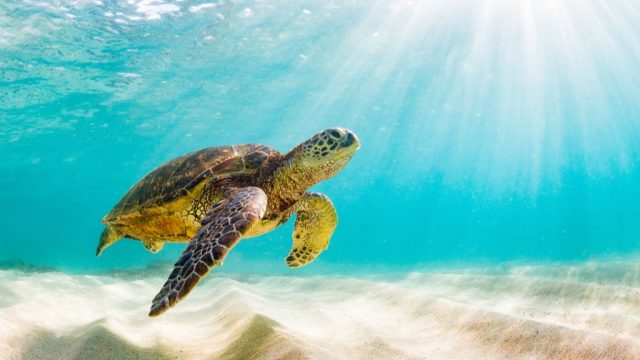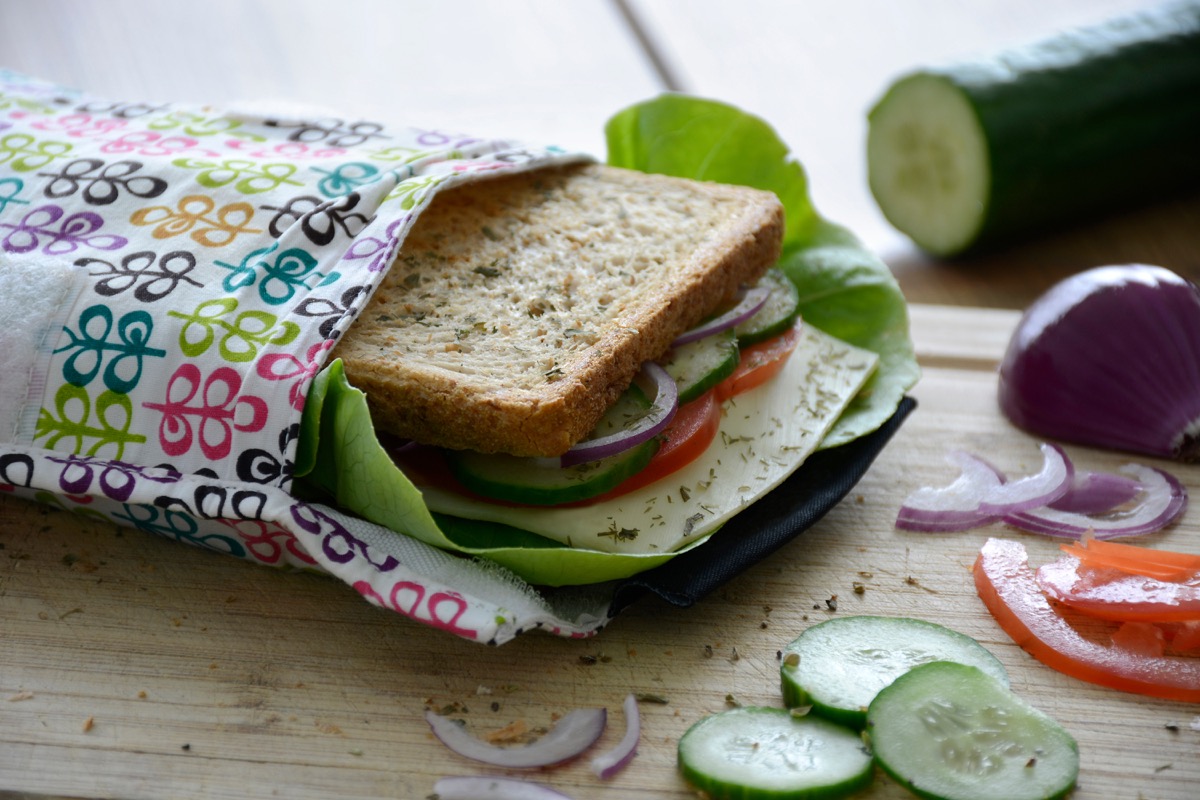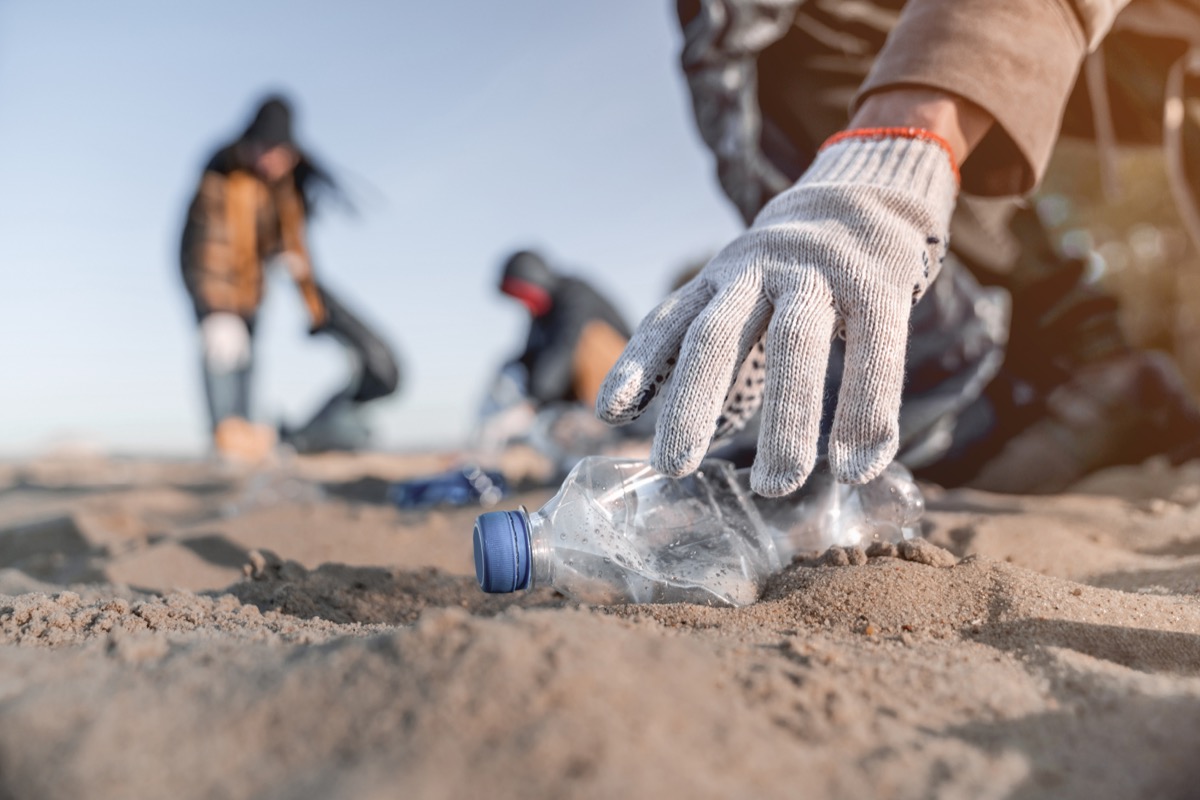10 Things You Can Do to Help Save the Turtles

Looking at a turtle and its tough shell, you might think that these animals are pretty good at protecting themselves. But they are far more vulnerable than many realize, with their populations decimated in recent decades by human activity and changes in environmental conditions. Almost every species of sea turtle is now endangered, endangered tortoises sell briskly on the black market, and some of the rarest sea turtle species have vanished altogether. In honor of World Turtle Day on May 23, it’s the perfect time to be reminded of all the things you can do to help protect these creatures. Here are 10 ways you can help save the turtles, according to turtle conservation experts. And for more suggestions on how to help out vulnerable animals, check out 17 Small Things You Can Do to Help Endangered Species.
1
Eat sustainably caught seafood.

One of the biggest threats to sea turtles is the fishing industry. The reptiles are often caught in fishing nets by accident (along with dolphins, sharks, and more) and die as a result. So what can you do to save these captured turtles? “You can help to guide fishing industries towards more turtle-friendly practices by consuming sustainably caught seafood,” urges Ashleigh Bandimere, sea turtle program coordinator for the Oceanic Society, a nonprofit organization dedicated to encouraging individuals to help in ocean conservation efforts.
The Oceanic Society offers a step-by-step guide–as does the World Wildlife Fund—to ensure you are buying and consuming seafood that has been sustainably sourced, and that no sea turtles were harmed in getting the fish to your table.
This effort extends to those who like to fish themselves, as well. When you’re trying to catch some dinner for yourself, be sure you aren’t leaving behind anything that can damage the sea turtles that share the habitat, like fishing line. “Discarded fishing lines often entangle turtles and can result in the amputation of their flippers,” says Mike Osmond, senior program officer at World Wildlife Fund-US.
2
Reduce the amount of plastic you use every day.

It was a disturbing video of a sea turtle with a straw stuck in its nostril that sparked the movement to ban plastic straws. And while that campaign has been surprisingly effective, it’s just the tip of the iceberg—or should we say, the peak of the mountain of garbage—when it comes to plastic refuse endangering sea turtles.
“Remember that each piece of plastic used will continue to exist forever, and could end up in the ocean, only to be mistaken for food and swallowed by a sea turtle,” says Bandimere. “You can directly help turtles by refusing single-use plastic, using reusable alternatives to plastic bags and containers, voting to ban plastics, and picking up trash at your local beach or waterway.”
But the first step is tracking all the plastic waste you create in a 24-hour period, says David Godfrey, executive director of the Sea Turtle Conservancy in Gainesville, Florida, which has recruited dozens of businesses throughout the state to ban the use of plastic straws.
After you track your plastic use, consider how much that adds up when all the people on your street, in your town, and across the country are taken into account. Then make small changes to cut back. “Start with something simple, such as switching plastic bags for reusable cloth bags, and work your way towards leading a plastic-free life,” says Godfrey. And for some more eco-friendly items to invest in, check out 15 Eco-Friendly Gifts That Give Back.
3
Cut down on chemicals.

Godfrey suggests that anyone looking to help save sea turtles should start with their lawn products. “Find biodegradable lawn and garden products that you can use and facilities that properly dispose of toxic chemicals,” he says. And Christine Madden Hof, marine species project manager at WWF-Australia, takes it one step further, saying “be careful what you put down your sink [and] wash from your driveways” as well.
“Everything ends up in the ocean and turtles are ingesting not only plastics but accumulating the chemicals as well,” Hof urges. “We know for some populations of turtles, these chemicals are having a negative impact on their health.” Hof points to WWF-Australia’s Rivers to Reef to Turtles project, which identifies the chemicals that pollute Australia’s rivers and the Great Barrier Reef.
4
Hold off on helium balloons.

If you’re hosting a socially distant beachfront barbecue or birthday party, skip the helium balloons. “Helium balloons can travel long distances, get caught in electric lines, and hurt animals like birds and sea turtles because, similarly to plastic bags, they can be mistaken for jellyfish,” says Brad Nahill, president and co-founder of SEE Turtles, which protects endangered sea turtles by supporting community-based conservation efforts.
Godfrey adds: “If you know of a group planning a balloon release, ask them to consider another attention getter.”
5
Think before you buy.

The shells of endangered tortoises and turtles are big business throughout the international black market. So do your part by avoiding anything that looks suspicious—particularly anything that involves the shell of the critically endangered hawksbill turtle. (Here’s how to identify a hawksbill turtle shell. You can get more information from the WWF.) “When traveling, ask vendors what souvenirs are made of and when in doubt, don’t purchase items in question,” urges Nahill.
6
Watch where you’re driving.

This one might seem obvious—we all try to avoid hitting animals when we’re driving—but because turtles are slow moving, low to the ground, and often travel at night, they can be particularly easy to overlook until it’s too late.
“Road mortality is a major problem for turtle populations,” explains Craig Stanford, professor of biological sciences and anthropology at the University of Southern California. “Make an effort not to hit turtles seen on the road. If you see one crossing the road, it’s often a female looking for a nesting site.”
Beyond just ensuring that you don’t hit the reptiles, you can help keep them from getting hit by other motorists. Stanford suggests that if you spot one on the road, pick her up and move her to the side of the road she was heading toward.
7
Use sea turtle-friendly lighting.

You may have heard of the term “light pollution,” but for sea turtles, light can literally be deadly. That’s because turtle hatchlings are attracted to light, and can become disoriented by artificial light near the beach, which can draw them further inland than they would normally go, putting them at risk of being attacked by predators or run over by cars.
“The best option is to turn exterior lights off during the nesting season—usually May through September—but sea turtle-friendly bulbs and fixtures are also available,” explains Godfrey, whose Sea Turtle Conservancy created a video on the topic and runs a beachfront lighting program. “By keeping light sources shielded from the beach and using LED lights with longer wavelengths—such as amber or red colors—hatchlings are far less likely to be disoriented.” And for ways to make your home eco-friendly, check out 30 Easy Ways to Make Your Home More Eco-Friendly.
8
Reduce your carbon footprint.

Climate change negatively impacts virtually every element of the global ecosystem, but its effects on sea turtles is particularly devastating.
“Survivorship of eggs incubating on beaches is being reduced by rising temperatures, and because the sex of hatchlings is determined by the temperature of nests, rising temperatures are producing mostly female turtles on many beaches—which poses a long-term threat to survival of the species,” explains Godfrey. “As sea levels rise, we are also seeing major impacts to nesting habitats.”
While tackling such a massive problem is overwhelming, there are steps each one of us can take to try to reverse the damage of climate change. For example, Bandimere suggests that “you can make an impact on climate change by voting for politicians and policies that support emission reductions, eating less meat, walking and biking more, and buying ethically made, higher quality products instead of higher quantities of lower quality items.”
9
Organize a beach cleanup.

Consider donating some time on World Turtle Day—or any day, for that matter—to helping sea turtles. “Many organizations that directly work with sea turtles rely on volunteers to accomplish their work,” says Bandimere. “Plus you have the chance to interact responsibly with some turtles.”
Godfrey also suggests that those who live near sea turtle populations join in a beach cleanup. “Plastic and marine debris are a major problem for sea turtles,” he says. “If you live near or are visiting a beach, how about conducting or participating in a beach cleanup? Removing trash and plastic from our beaches is good for sea turtles, shorebirds, and us.” Bonus: It’s a do-good activity that you can participate in at a safe six-foot distance!
10
Make a donation.

Even if you don’t live near major turtle habitats, that doesn’t mean you can’t do your part to help in the efforts to protect sea turtles. All the various organizations cited in this article are doing worthy work to help protect turtle populations, and they could use your financial support.
The World Wildlife Fund operates an Adopt a Sea Turtle program that helps protect the animals from the aforementioned dangers (and a monthly donation comes with an adoption kit complete with stuffed sea turtle). The Oceanic Society accepts donations for its efforts to combat pollution and climate change, and to help cultivate sustainable fisheries and aquaculture. Sea Turtle Conservancy offers its own Adopt-a-Turtle program to help the Florida sea turtle populations. Stanford also suggests financially supporting the Turtle Survival Alliance and the Turtle Conservancy.
And SEE Turtles’ Sea Turtle Emergency Fund supports community-based projects around the world. “Sea turtle projects around the world have been impacted by the COVID-19 pandemic,” they note. “The combination of the loss of income and help covering nesting beaches from international volunteers and travelers with increased desperation for food and income is resulting in increased turtle egg collection and hunting.” If you can afford it, $10 saves at least 100 hatchlings!